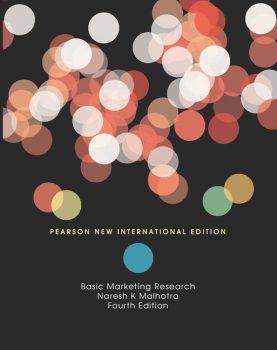This course covers the entire research process: problem definition, data collection methods, sample design, collection of data, tabulation and analysis, and presentation of results.
It is a competitive world out there, and it is the information age! Marketing is made of different elements and marketing research links all these elements together. Information, in addition to its linking role, empowers the marketing process and allows for better marketing decision-making. You will appreciate in this course the value data in terms of impacting outcome. You will also realize the difference between decision-making and relying on experience and one instinctive approach is expensive to the business community. You will be exposed to the realities of marketing research prevailing in our business environment.
The aim of the course is to teach you the fundamental concepts of Marketing Research as well as their applications. It will also stress the relation between the research process and the marketing decision making process from identifying the need for data all the way to implementation and feedback. You will also learn the application of the different basic concepts through a real world application: the term project.
This course comprises a mix of lectures, business cases, discussions, videos, in-class group workshops and class presentations. Students are highly encouraged to ask questions and actively participate in class. They frequently work in pairs or teams to give deeper meaning to the reading material. The last couple of weeks of the course will make the culmination of assigned semester-long projects. Students share their findings with their peers and get to reinforce the knowledge, skills and competencies they will have learned.
Enrolment is now open for January, April, July, or October. Please contact us for more information.
Course Name | Code: Marketing Research | CMKT 202
Pre-requisite: CMKT 101 | Principles of Marketing
Course Fees: $775
Delivery: Virtual Instructor-Led
Platform: Zoom, Microsoft Teams, or similar
Duration: 11 weeks / 42 hours / 11 weekly sessions / 4 hours per session
This course is one of the eight required courses to obtain the International Marketing Management Diploma. more
Course Outline
| Session | Topic | Learning Outcomes |
| 1 | The Role of Marketing Research | * Define marketing research * Discuss different kinds of firms that conduct marketing research * List some of the skills that are important for careers in marketing research * List three reasons for studying marketing research |
| 2 | Gathering Marketing Intelligence: The Systems Approach | * Explain the difference between a project emphasis in research and a systems emphasis * Define what is meant by a marketing information system (MIS) and a decision support system (DSS) * Identify the components of a decision support system * Discuss trends in the gathering of marketing intelligence |
| 3 | Gathering Marketing Intelligence: The Project Approach | * Explain the difference between a program strategy and a project strategy in marketing research * Outline the steps in the research process and show how the steps are interrelated * Cite the most critical error in marketing research * Highlight the main differences between the utility, justice, and rights approaches to ethical reasoning |
| 3 | Problem Formation | * Specify the key steps in problem formulation * Discuss two objectives of the initial meeting with the research client * Discuss the two general sources of marketing problems/opportunities * Explain why the researcher must be actively involved in problem formulation |
| 4 | Problem Formation | * Distinguish between two types of decision problems * Distinguish between a decision problem and a research problem * Describe the research request agreement * Outline the various elements of the research proposal * Describe types of research that should be avoided * Describe the purpose of a request-for- proposal (RFP) |
| 4 | Types of Research Design and Exploratory Research Descriptive and Causal Research Designs | * Explain what a research design is * List the basic types of research design * Describe the major emphasis of each type of research design * Describe the basic uses of exploratory research * Specify the key characteristics of exploratory research * Discuss the various types of exploratory research and describe each |
| MIDTERM | ||
| 5 | Descriptive and Causal Research Designs | * Cite major purposes of descriptive research * List the specifications of a descriptive study * Explain what a dummy table is * Discuss the difference between cross-sectional and longitudinal designs * Explain what is meant by a panel in marketing research and explain the difference between a continuous panel and a discontinuous panel * Describe the emphasis in sample surveys * Clarify the difference between laboratory experiments and field experiments * Explain which of the two types of experiments has greater interval validity and which has greater external validity * List the major considerations in test marketing * Distinguish between a standard test market and a controlled test market * Discuss the advantages and disadvantages of simulated test marketing |
| 6 | Secondary Data | * Explain the difference between primary and secondary data * Cite advantages offered by secondary data * Specify problems common to secondary data * List the criteria researchers should use in judging the accuracy of secondary data * State the most fundamental rule in using secondary data * Explain the difference between primary and secondary data * Cite two advantages offered by secondary data * Specify two problems common to secondary data * List the three criteria researchers should use in judging the accuracy of secondary data * State the most fundamental rule in using secondary data |
| 7 | Collecting Primary Data Collecting Information by Communication | * List the kinds of demographic and socioeconomic characteristics that interest marketers * Discuss the rationale for lifestyle analysis * Cite the main approaches used to measure the effectiveness of magazine ads * Give two reasons why researchers are interested in people’s motives * Describe the basic means of obtaining primary data * State the specific advantages of each method of data collection * Explain the concept of structure as it relates to questionnaires * Cite the drawbacks of using high degrees of structure * Explain what is meant by disguise in a questionnaire context * Discuss situations in which disguise might be desirable * Differentiate among the main methods of administering questionnaires * Discuss important aspects used to compare the different methods of administering questionnaires |
| 8 | Collecting Information by Observation Asking Good Questions: Measurement Basics | * Explain the primary advantage of collecting data via observation * List the important considerations in the use of observational methods of data collection * Cite the main reason researchers may choose to disguise the presence of an observer in a study * Explain the advantages and disadvantages of conducting an observational experiment in a laboratory setting * Define response latency and explain what it measures. * Define voice-pitch analysis and explain what it measures * Explain how researchers use eye cameras * Define the term measurement as it is used in marketing research * List the four types of scales that can be used to measure an attribute * Explain the primary difference between a ratio scale and an interval scale * Name the types of error that may affect measurement scores and define * Explain the concept of validity as it relates to measuring instruments * List general types of validity that can be used to assess the quality of a measure * Outline the sequence of steps to follow in developing valid measures of marketing constructs. |
| 9 | Developing the Sampling Plan Determining Sample Size | * Explain the difference between a census and a sample * List the six steps researchers use to draw a sample of a population * Explain the difference between a parameter and a statistic * Explain the difference between a probability sample and a non-probability sample * Explain what a judgment sample is and describe its best use and its hazards * Define quota sample * Specify the two procedures that distinguish a stratified sample * Cite two reasons researchers might choose to use a stratified sample rather than a simple random sample * Explain the difference between a proportionate stratified sample and a disproportionate stratified sample * List the steps followed in drawing a cluster sample * Cite factors researchers must take into account when determining sample size * Specify the relationship between precision and confidence * Explain in what way the size of the population influences the size of the sample * Specify the circumstances under which the finite population correction factor should be used * List the methods of determining sample size for a project |
| FINAL EXAM |

